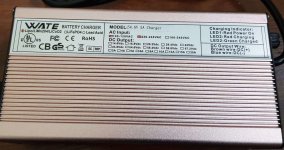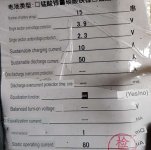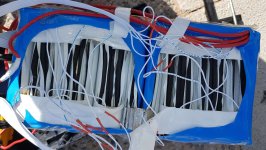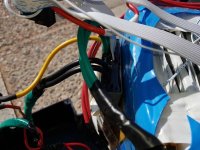FSC said:
I took some time and disassembled the pack again. Bellow you will find a simple schematic of the electrical wiring. Unlike I previously believed that it was two 48V packs, it actually is one pack. I am not sure how many cells there are exactly as I was afraid to disassemble too much. But it looks like 15s4p, but I am not too sure about that. It looked a bit ...messy. It is a bit odd for me why there are two wires for GND and positive.
bat.png
They're probably just using thinner cheaper wire doubled up for higher current flow, instead of a single thicker wire. Saves money on wire and also on tools/labor to connect, since it's harder to solder thicker wires correctly.
I quickly tested cell voltages using the contacts in one side and they all measured 6.61 V (battery was not fully charged when measured)… so right now they seem to be balanced…?
6.61v is WAY WAY too high, a severe overcharge, for any LiFePO4 cell, if you are actualy measuring across just one cell in each case. No cell should read more than 3.6-3.65v normally, and if the BMS is working, worst case would be 3.9v/cell based on the HVC it lists on the label.
I suspect the measurement you're doing is across pairs of seriesed cells, or that your multimeter's battery is low (which will cause a higher reading than reality).
If it's across pairs of cells, then 6.61v / 2 = 3.305v. 3.3v or so is about what LiFePO4 cells often charge to once their ability to take and/or hold a "surface charge" up to 3.6ish V wears out. If this is what they're all actually at, then the reason they're not charging higher is just age, rather than imbalance.
Can you verify where you are placing each of the meter leads? Normally, if measuring on the BMS sense-wire connector itself (the thin wires), you'd start at the most negative wire on that connector, with black meter lead there, red lead on next wire. Note the reading, then move black lead to where the red lead is, then the red lead to the next wire, and note that reading. Proceed until all wire pairs are tested, and you have 15 voltages noted down.
It's unlikely they will all be exactly the same voltage to the hundredth, especially if the BMS is not balancing; I only usually see this with EV-grade cells being used well-within their limitations, rather than the typical cells in these types of packs which are usually used close to their limitations.
About charger. When the charger is disconnected, it shows green LED (voltage 54.6 at charger cable and 0V in charging port). When charger is connected and cut by BMS at 52V (measured at charging port) it is also green. I am not too deep into electronics, but I would assume that when BMS disconnects charging, the voltage in charger should bounce to 54.6, but that is not happening(I see j Bjork was wondering the same). Also if charger is disconnected the charger port shows 0 V. However charger still thinks the pack is full. So is charger measuring current to decide if battery is full?
It probably is; as noted in my first reply, Li-Ion chargers tend to monitor output current and turn off the output once current drops below a certain level. They may also have other off-triggers, such as if the voltage jumps up (like when unplugged from a pack removing the load). When disconnected and reconnected (like if the BMS turns off the input to balance, then turns it back on to continue charging), they'll turn back on until one of the triggers engages and turns it off.
The charger voltage probably does bounce up, but when it does the charger then shuts off it's output, so then you are reading the "leakage" out of the BMS FETs. With no load on the port to drain the "ghost charge" on the port, it will read approximately the same as the voltage on the "inside" of the port, at the pack. This isn't always the case, but it's common.
It seems odd without knowing how they work inside, but FETs aren't really the same as a real switch or relay, they are semiconductors, so they always have some leakage since no physical connection is actually broken by them. Many chargers actually use a relay on their output for this reason, to ensure they are actually disconnected under whatever conditions they are designed to do so.
The old charger died of natural causes (fatigue on main coil fixing due vibration of being carried around with the scooter caused SC)
charg.jpg
Oops.

We've seen that type of failure before with inductors, capacitors, and even transformers not secured to the PCB.

Some of us use potted chargers partly for that reason, like the adjustable Meanwell HLG-600H-54A LED PSU I use on the SB Cruiser trike, mounted underneath it. (potted ones are also usually waterproof, an added bonus).
The range of the battery has dropped from 55km to 40km in last 50-70 charging cycle. Based on mileage on the scooter, the battery pack has seen about 250-300 charging cycles. This made me think that is there issues with charging or the battery.
That's a pretty low amount of cycles for a "good" LiFePO4, usually you'd see 3-4 times that many before severe degradation. (Li-Ion on the other hand may only survive 100-300 cycles, depending on the specific cell, usage, etc.; some are much better than that).
The lower the proportion of battery capacity that is used each cycle, the more cycles you'll get, regardless (and usually the less balancing issues you'll have, because they are less stressed at the extremes of voltage). Meaning, if you only charge up to say, 80-90% full, and only discharge to say, 20-30% full, you might see quite a lot longer lifespan. Depends on the specific cells, and also the usage conditions (how much current is pulled especially at lower states of charge, vs what the cells are designed for). In this case, you haven't really got any way to know what the cell specs are (even if the battery seller had a rating for them, you can't really trust it; you'd need to have manufacturer specs to know what they would really be--sellers often say anything to get you to buy something

).
There are a lot of threads about extending lifespan of cells/batteries, with varied info depending on experience of the posters. I have not attempted to quantify any of my own battery experiences this way, so am only posting generalities of what I've read of other's.
If I understood correctly there is no point fine-tune the charger unless I replace the BMS? Is there point on replacing BMS or is the pack just so degraded? What do you think?
Yes, there isn't any reason to fine tune it if the BMS doesn't do balancing anyway. A lower voltage is actually better in this case, because the cells risk less overcharge in the event of imabalance severe enough to cause that.
Replacing the BMS may help the pack's usefulness *if* it has a balance issue now. If it does not, a balancing BMS has nothing to fix, and it's just degraded cells causing the problem, so replacing the pack would be the only real option to fix that.













